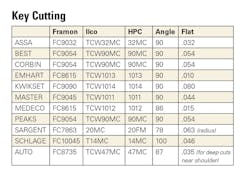Code machines are one of the most important tools a locksmith can own. While there have been dozens of variations in code machine designs over the years, the basic design remains the same. Settable depth and space locations allow a locksmith to produce a working key with the general cut contour equal to an original factory-cut key.
Keys are set onto a straight surface in the key vise which serves as the zero depth location. Most key blanks are designed with a straight, flat surface along the bottom of the key blade. As the key blank is inserted into the key vise, the straight surface of the key vise provides a mating surface for the flat surface of the key blank. When the key vise jaw is tightened, the key is held parallel with the vise jaw in preparation for the cutting procedure.
Key vises in code machines travel left and right (X axis), plus forward and back (Y axis). Depth and space measuring has been refined over the years to the point where the locksmith industry has a general agreement on measurements for almost all known individual types of keys. While there are many different code machines available, and each machine has some unique system for moving a key into each necessary position, the result should be a key cut to exacting original factory specifications.
Most lock designs can be separated into two types, wafer locks and pin tumbler locks. Wafer tumblers are usually approximately .025" thick. Popular pin tumbler sizes include diameters of either .095 or.115. Since thin wafer tumblers can be installed close together, spacing from cut-to-cut for wafer locks is usually factory-set between .083 and .098. Cut-to-cut spacing for locks using .095 diameter pin tumblers is usually set between .109 and .140. Cut-to-cut spacing for larger .115 diameter pin tumblers is usually set between .150 and .160. Flat, slotter cutter key cutting will be covered in a subsequent article.
Aside from correctly installing key blanks in the code machine vise jaw, using the proper cutter blade is the next most important procedure. Because many locks have similar characteristics, code machine manufacturers have settled on two standard cutter blades which can originate a large percentage of key types. For locks using cut-to-cut dimensions less than .140, manufacturers have a narrow cutting blade which has a 90-degree cutting angle and a .044 flat (Example: Framon FC9045). For locks using cut-to-cut dimensions wider than .140, manufacturers have a wide cutting blade with a 100-degree cutting angle and .045 flat (Example: Framon FC10045). Our chart shows some of the specialty blades required when cutting keys to factory dimensions.
Every cutter listed here has a "V" shape. When a very deep "V" cut is made adjacent to a very shallow cut, the cutter may remove too much material and the adjacent shallow cut cannot be made. Each lock has a set maximum adjacent cut factor (MAC). Key code series already take MAC into account and omit cuts which violate the MAC rule. However, when originating keys for a change combination and not making cuts from a code series, care must be taken to not violate the MAC rule for that particular lock cylinder. Also check to see that each cut has a smooth "V" shaped transition to the adjacent cuts. If any vertical 'fishhooks' exist, they must be filed smooth or the key may either not enter the lock or may not be able to be retracted.
With a good code machine, the right depth & space information, and with the correct cutter blades, key origination is what sets us apart from common key duplicators at big box stores.
Key Cutting
Framon Ilco HPC Angle Flat
ASSA FC9032 TCW32MC 32MC 90 .032
BEST FC9054 TCW90MC 90MC 90 .054
CORBIN FC9054 TCW90MC 90MC 90 .054
EMHART FC8615 TCW1013 1013 90 .010
KWIKSET FC9090 TCW1014 1014 90 .080
MASTER FC9045 TCW1011 1011 90 .044
MEDECO FC8615 TCW1012 1012 86 .015
PEAKS FC9054 TCW90MC 90MC 90 .054
SARGENT FC7863 20MC 20FM 78 .063 (radius)
SCHLAGE FC10045 T14MC 14MC 100 .046
AUTO FC8735 TCW47MC 47MC 87 .035 (for deep cuts near shoulder)
Key Cutting
|
|
Framon |
Ilco |
HPC |
Angle |
Flat |
|
ASSA |
FC9032 |
TCW32MC |
32MC |
90 |
.032 |
|
BEST |
FC9054 |
TCW90MC |
90MC |
90 |
.054 |
|
CORBIN |
FC9054 |
TCW90MC |
90MC |
90 |
.054 |
|
EMHART |
FC8615 |
TCW1013 |
1013 |
90 |
.010 |
|
KWIKSET |
FC9090 |
TCW1014 |
1014 |
90 |
.080 |
|
MASTER |
FC9045 |
TCW1011 |
1011 |
90 |
.044 |
|
MEDECO |
FC8615 |
TCW1012 |
1012 |
86 |
.015 |
|
PEAKS |
FC9054 |
TCW90MC |
90MC |
90 |
.054 |
|
SARGENT |
FC7863 |
20MC |
20FM |
78 |
.063 (radius) |
|
SCHLAGE |
FC10045 |
T14MC |
14MC |
100 |
.046 |
|
AUTO |
FC8735 |
TCW47MC |
47MC |
87 |
.035 (for deep cuts near shoulder) |
|
|
|
|
|
|
|
|
|
|
|
|
|
|
About the Author

